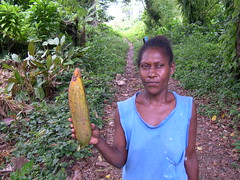- African data centre planned.
- “…genetic variability and phenotypic plasticity of plant anti-herbivore defences allow plant populations to rapidly respond to changing environmental conditions.” In a crop wild relative, no less.
- The genetics of chicken domestication. I’d like to see the results of those crosses.
- Do you have these heirloom tomatoes?
- Getting increased heat tolerance from a wild relative into wheat.
Zombi bean resurrected?
Vigna vexillata is a close relative of the cowpea (V. unguiculata) that (sometimes) rejoices in the common name Zombi Bean. (It is also called the tuber cowpea.) It’s hard to tell whether this is a “famine food” harvested from the wild, a plant being domesticated and on its way to becoming a crop, or a full-fledged crop species. Either way, scientists in Australia have been doing their darndest to understand how it can best be improved. The result, so far, is three back-to-back papers in Crop & Pasture Science.
- Genotypic variation in domesticated and wild accessions of the tropical tuberous legume Vigna vexillata (L.) A. Rich. doi:10.1071/CP10029
- Genetic compatibility among domesticated and wild accessions of the tropical tuberous legume Vigna vexillata (L.) A. Rich. doi:10.1071/CP10060
- Expression of qualitative and quantitative traits in hybrids between domesticated and wild accessions of the tropical tuberous legume Vigna vexillata (L.) A. Rich. doi:10.1071/CP10084
But not, yet, any improved varieties.
Mashing up banana wild relatives
Over at the Vaviblog is a detailed discussion (though not nearly as detailed as the paper) of a new paper outlining a new theory for the origin of the cultivated banana. 1
Edible bananas have very few seeds. Wild bananas are packed with seeds; there’s almost nothing there to eat. So how did edible bananas come to be cultivated? The standard story is that some smart proto-farmer saw a spontaneous mutation and then propagated it vegetatively. Once the plant was growing, additional mutants would also be seen and conserved. In fact this “single-step domestication” is considered the standard story for many vegetatively-propagated plants, such as potato, cassava, sweet potato, taro and yam. And while it may be true for those other crops, evidence is accumulating that it may not be the whole story for bananas.
Leaving the details aside, De Langhe and his colleagues propose that instead of a single step, at least two were involved, with a proto-cultivated banana back-crossing with one of its wild relatives and then being seen by the proto-farmer as an improvement to be added to her proto-portfolio of agricultural biodiversity. Something very like that is going on today among cassava farmers, for example; they allow volunteer seedlings, the product of sexual reproduction between already favoured clones and wild relatives, to flourish in their fields and then select among them. 2 Banana farmers could easily have done the same.
To quote again from The Vaviblog:
The big question, of course, is “what does any of this matter?”. And the surprise is that it really does. Banana breeding is difficult at the best of times; no seeds, no pollen, you can imagine. But if the backcross hypothesis is true, then the current approach to banana breeding, which De Langhe et al. describe as “substituting an A genome allele by an alternative derived from a AA diploid source of resistance or tolerance to biotic and abiotic stress”, might be misguided. If the chromosomes are not “pure” A or B, and if backcrosses were involved in the origin of banana varieties, maybe breeders should look again at some of the diploid offspring from their crosses and see whether they could be further backcrossed to come up with types that are more use to farmers.
Now, what I really need is for one of the handful of people who really understand this stuff to tell me where I’ve misunderstood it.
Nibbles: Abalone, Yak, Forests, Mountain plants, Yams, Ulmus, Apple, Banana
- We now know how to harvest abalone sustainably. Is there anything we cannot do?
- Wild yaks get assessed. Wait, there are wild yaks?
- “…forests played a central role in the rise of the modern state.” Not as flaky as it sounds.
- Andean plants at risk from, well, everything.
- Yams in Nigeria, from festivals to in vitro.
- London’s elms.
- “[L]ike biting into a perfume bottle, but without shards of glass piercing your tongue.” A knobbed russet.
- Banana evolution just got more complicated.
Bananas in the Solomons Islands
The Solomon Islands is one of the birthplaces of bananas – plants that grow only by human hands, for they have been bred to lack the ragged, rock-hard seeds of their wild ancestry – and there are more kinds of bananas here than there are types of breakfast cereal in an American supermarket.
